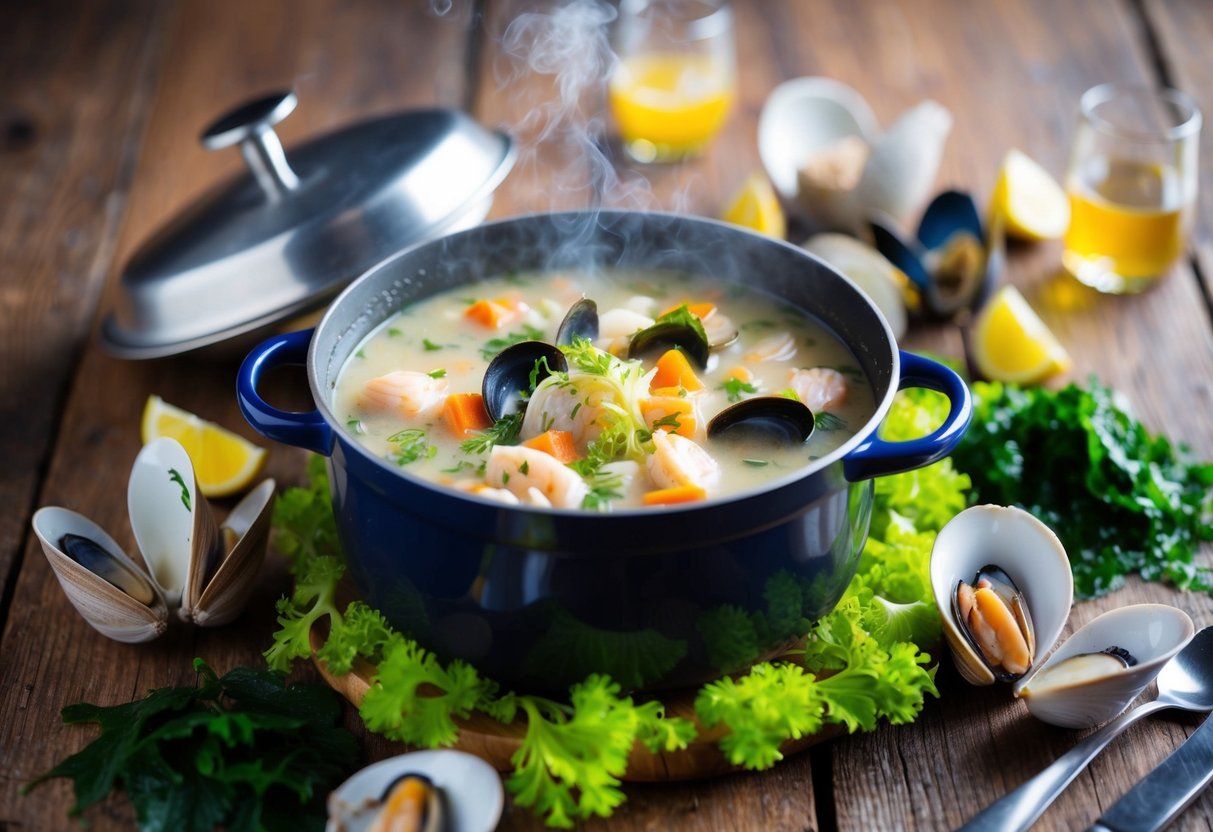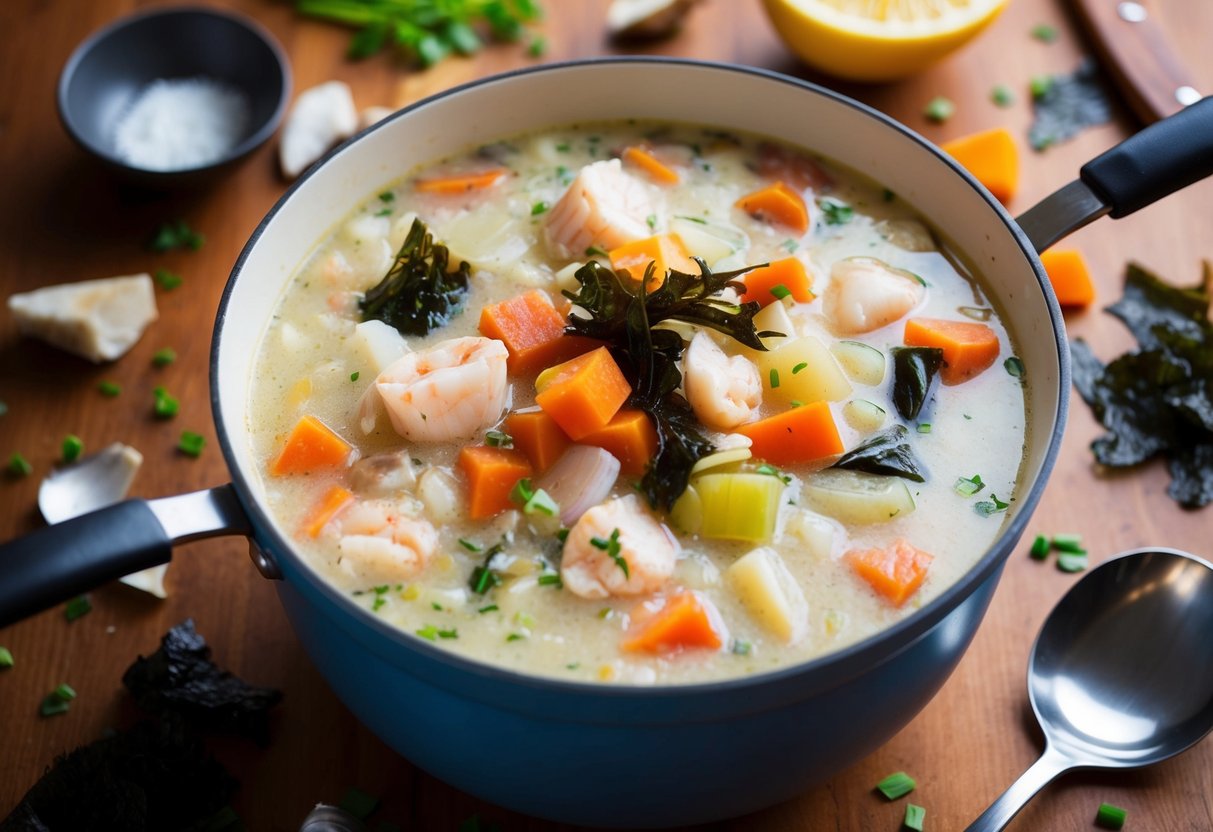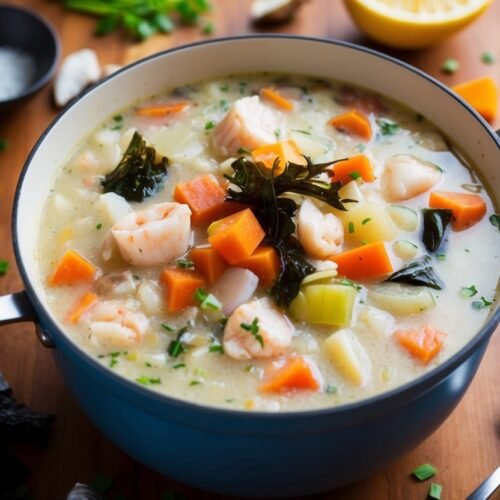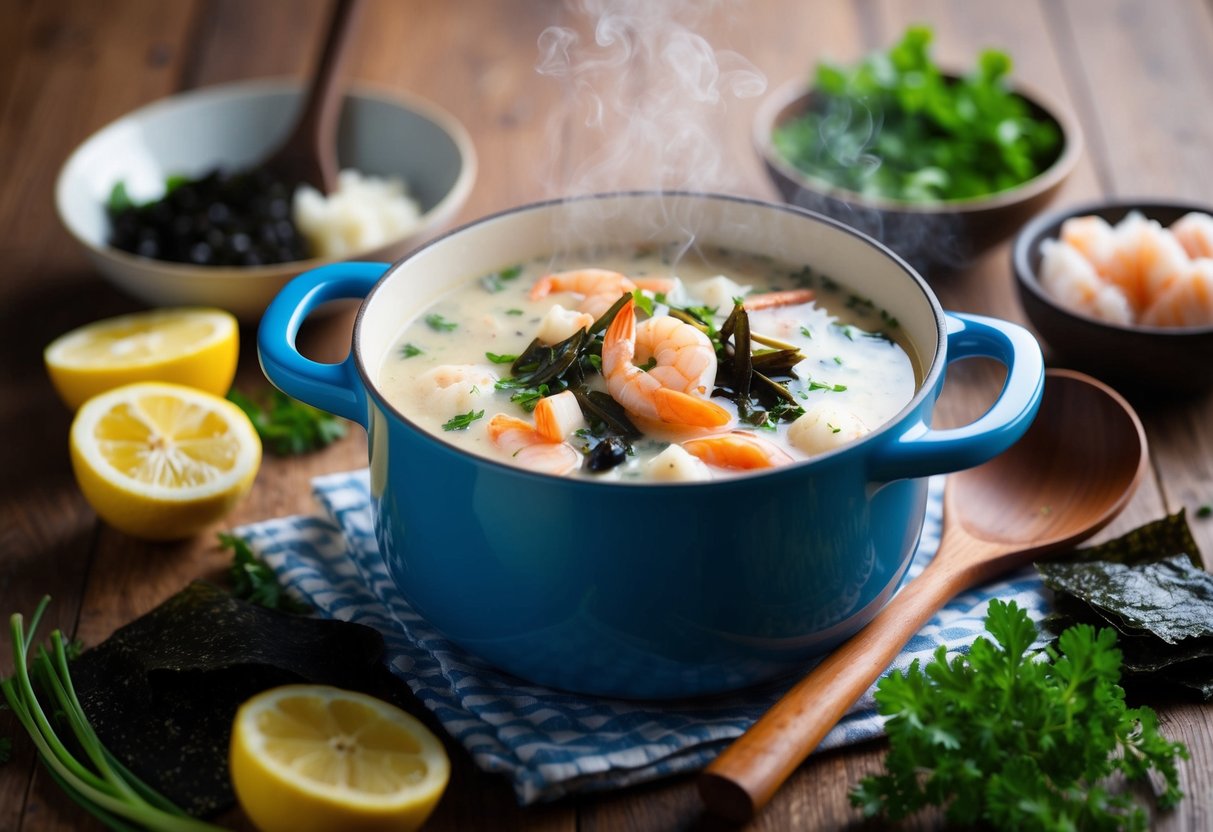This post may contain paid and/or affiliate links. I may make a small commission at no extra cost to you. Please see our Privacy Policy.
When I think about comfort food, Seafood-and-Seaweed Chowder stands out as a heartwarming dish that combines rich flavours and nourishing ingredients.
This chowder not only showcases a medley of fresh seafood, but also incorporates the umami boost that seaweed provides.
It’s a perfect recipe for those cool evenings when I crave something warm and satisfying.
Jump to Recipe
In exploring the best seafood chowder recipe, I find that using a mix of shrimp, scallops, and fish can create a delightful blend of textures and tastes. The addition of seaweed enhances the meal with nutrients and a unique depth of flavour that elevates the traditional chowder experience.
This dish can easily become a staple in my kitchen, as it is both delicious and hearty.
As I prepare to share my thoughts and the recipe for this Seafood-and-Seaweed Chowder, I trust that you’ll find it an enjoyable dish to make and share.
With simple steps and easily accessible ingredients, this chowder can transform any meal into a special occasion, inviting everyone to gather and enjoy.
Ingredients and Preparation

In preparing Seafood-and-Seaweed Chowder, it is essential to gather the right ingredients and use specific cooking implements. The combination of fresh seafood and flavoursome aromatics will create a rich, comforting dish that’s full of depth.
Essential Ingredients
For this chowder, I focus on fresh, quality ingredients. The backbone of my chowder includes butter, onion, celery, and carrots.
I sauté these in a Dutch oven to build a strong flavour base. Potatoes are added for heartiness, and they balance out the rich seafood.
The real stars are the seafood components. I typically use clams, shrimp, and scallops, with options like cod or haddock for added taste. I often enhance the flavour with seaweed varieties such as nori and kelp, which contribute a briny depth to the dish. Seasoning with sea salt, dill, thyme, and bay leaves elevates the overall taste profile.
Cooking Implements
Having the right tools is crucial for crafting this chowder. I recommend using a large pot or Dutch oven to accommodate all the ingredients. A heavy-bottomed pot helps to distribute the heat evenly, preventing any burning.
A good wooden spoon is essential for stirring, ensuring I can combine everything well without scraping the pot’s surface.
Measuring cups and spoons are necessary for precise amounts of cream and seasonings.
Depending on my preference, I choose between heavy cream, half-and-half, or even whole milk for the chowder’s richness. These tools make the cooking process streamlined and enjoyable.
Chowder Bases and Creams
The base of my chowder starts with a homemade seafood stock. I use the shells from the shrimp and other seafood to create a rich broth, which enhances the chowder’s flavour.
Preparing the stock involves simmering the shells with aromatics such as garlic, leeks, and bay leaves.
Once the stock is ready, I strain it and use it as the foundation for the chowder. The addition of cream or butter gives it a luxurious consistency.
I often choose heavy cream for a thicker texture, or half-and-half if I prefer something lighter. The choice of cream will impact the chowder’s richness, making it a personal touch in the recipe.
Cooking Techniques and Serving Suggestions
Preparing a delicious seafood-and-seaweed chowder involves specific cooking techniques and thoughtful serving suggestions. I find these elements enhance the overall experience of enjoying this dish.
Culinary Techniques
For a successful chowder, I start by sautéing a yellow onion in canola oil over medium-low heat. This brings out the natural sweetness of the onions.
Next, I add diced russet potatoes and red potatoes for a creamy texture. Cooking them until tender is key.
Incorporating clam juice adds depth, while a combination of dried kelp and ground nori gives that unique sea flavour.
When adding the seafood, I prefer using skinless pollock, lobster meat, and other fresh options like halibut. I cook the chowder just until the seafood is opaque. It’s important not to overcook to maintain the quality of the seafood.
Finishing and Garnishes
Once my chowder is ready, I season it with fine sea salt, pepper, and a sprinkle of Old Bay seasoning for that extra zing.
To finish, I melt a bit of butter and add a splash of dry hard cider. This adds a rich and unique flavour that elevates the dish.
For garnish, I love using fresh dill and a squeeze of lemon for brightness. I often serve the chowder alongside oyster crackers or crusty bread. These additions make for a hearty meal that complements the chowder beautifully.
Leftovers and Storage
If I have any leftover seafood chowder, I ensure it cools completely before transferring it to an airtight container. It’s best stored in the fridge and consumed within three days.
I often reheat it gently on the stove over low heat, adding a splash of water if it thickens too much.
Using a microwave is an option, but I prefer the stove to maintain the chowder’s creamy texture. Adding a bit of clam juice when reheating can enhance the flavours and prevent drying out. Enjoying chowder this way makes for a comforting second meal.
Seafood-and-Seaweed Chowder
Ingredients
For the Chowder Base:
- 2 tbsp butter
- 1 tbsp olive oil
- 1 large onion, diced
- 2 cloves garlic, minced
- 2 carrots, peeled and diced
- 2 celery stalks, chopped
- 2 medium potatoes, peeled and diced
- 1 tsp fresh thyme leaves (or 1 tsp dried thyme)
- Salt and black pepper, to taste
- 4 cups (950ml) seafood stock or fish broth
- 1 cup (240ml) heavy cream
For the Seafood:
- 1 lb (450g) mixed seafood (shrimp, scallops, white fish, etc.) – cut into bite-sized pieces
- 1/2 cup (120ml) diced kelp or dried seaweed (nori, dulse, or wakame), soaked and chopped
- Juice of 1 lemon (optional)
For Garnish:
- Fresh parsley, chopped
- Lemon wedges, for serving
Instructions
1. Sauté the Vegetables
- In a large pot or Dutch oven, heat the butter and olive oil over medium heat. Add the diced onion, garlic, carrots, and celery. Sauté for about 5 minutes until softened and aromatic.
- Add the diced potatoes and thyme. Season with salt and black pepper. Stir everything together.
2. Simmer the Chowder Base
- Pour in the seafood stock (or fish broth) until the potatoes and vegetables are fully covered. Bring everything to a gentle boil.
- Reduce the heat to low, cover the pot, and let it simmer for about 15-20 minutes until the potatoes are tender.
3. Add Seafood and Seaweed
- Stir in the mixed seafood and chopped seaweed into the pot.
- Pour in the heavy cream and gently stir everything together. Simmer for another 5-7 minutes until the seafood is cooked through and the chowder has thickened slightly.
- Squeeze in the lemon juice for an extra pop of brightness (optional). Taste and adjust seasoning with more salt and pepper if needed.
4. Garnish and Serve
- Serve the chowder hot, garnished with fresh parsley.
- Serve alongside crusty bread or crackers and lemon wedges for an added touch.

Seafood-and-Seaweed Chowder
Ingredients
For the Chowder Base:
- 2 tbsp butter
- 1 tbsp olive oil
- 1 large onion diced
- 2 cloves garlic minced
- 2 carrots peeled and diced
- 2 celery stalks chopped
- 2 medium potatoes peeled and diced
- 1 tsp fresh thyme leaves or 1 tsp dried thyme
- Salt and black pepper to taste
- 4 cups 950ml seafood stock or fish broth
- 1 cup 240ml heavy cream
For the Seafood:
- 1 lb 450g mixed seafood (shrimp, scallops, white fish, etc.) – cut into bite-sized pieces
- 1/2 cup 120ml diced kelp or dried seaweed (nori, dulse, or wakame), soaked and chopped
- Juice of 1 lemon optional
For Garnish:
- Fresh parsley chopped
- Lemon wedges for serving
Instructions
- In a large pot or Dutch oven, heat the butter and olive oil over medium heat. Add the diced onion, garlic, carrots, and celery. Sauté for about 5 minutes until softened and aromatic. Add the diced potatoes and thyme. Season with salt and black pepper. Stir everything together.
- Pour in the seafood stock (or fish broth) until the potatoes and vegetables are fully covered. Bring everything to a gentle boil.
- Reduce the heat to low, cover the pot, and let it simmer for about 15-20 minutes until the potatoes are tender.
- Stir in the mixed seafood and chopped seaweed into the pot.
- Pour in the heavy cream and gently stir everything together. Simmer for another 5-7 minutes until the seafood is cooked through and the chowder has thickened slightly.
- Squeeze in the lemon juice for an extra pop of brightness (optional). Taste and adjust seasoning with more salt and pepper if needed.
- Serve the chowder hot, garnished with fresh parsley.
- Serve alongside crusty bread or crackers and lemon wedges for an added touch.
Frequently Asked Questions

I’ve gathered some common questions about seafood chowder. This section covers essential ingredients, ways to thicken the chowder, popular variations, and differences between bisque and chowder.
What ingredients are essential for a traditional seafood chowder?
For a traditional seafood chowder, I include a mix of fresh seafood like shrimp, clams, and fish. They pair well with potatoes, onions, and celery. Using a good seafood stock enhances the flavour, while cream or milk adds richness.
How can one achieve a thicker consistency in a seafood chowder?
To achieve a thicker consistency, I often mash some of the potatoes in the chowder. This creates a creamy texture.
Adding a roux made from flour and butter or using cornstarch slurry can also help thicken the broth effectively.
Can you provide a simple and easy-to-follow seafood chowder recipe?
Certainly! To make seafood chowder, I start by sautéing onions, celery, and potatoes. Then I add seafood stock and let it simmer. After that, I toss in the seafood and finish with cream. A quick and simple recipe that yields great flavour.
What are the key differences between a seafood bisque and a seafood chowder?
The main difference between seafood bisque and chowder is in the texture. Bisque is usually smooth and creamy, often made by blending. Chowder, on the other hand, is chunky and remains more broth-like, highlighting the ingredients’ textures.
Which thickening agents work best in a seafood chowder?
I find that several thickening agents work well in seafood chowder. Mashed potatoes are a great natural option. Other choices include a roux, cornstarch, or even using a blend of puréed seafood with cream for added flavour.
What are some of the most popular variations of seafood chowder recipes?
Popular variations of seafood chowder include New England-style and Manhattan-style. New England-style chowder is creamy, while Manhattan-style chowder has a tomato base. You can also add ingredients like sweet corn or smoked fish to create different flavor profiles.
